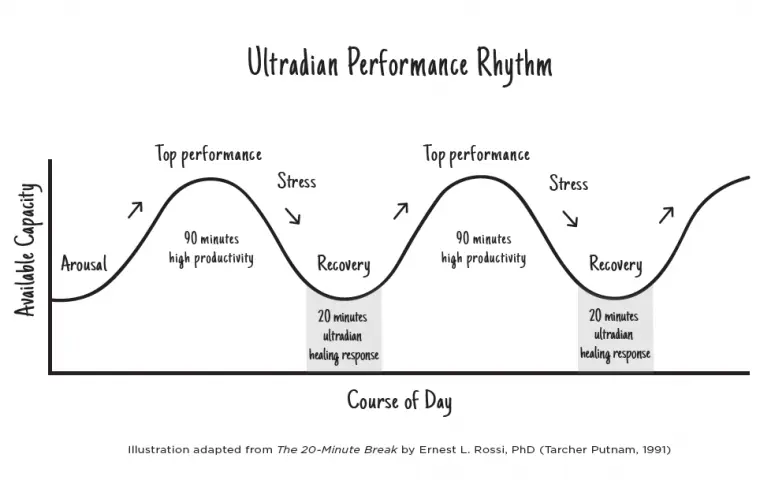The 'Ultradian Rhythm' is a vital yet under-appreciated aspect of human bio-rhythms.' These rhythmic cycles, which occur multiple times within a 24-hour period, dramatically influence an individual's energy levels, focus, mood, and productivity.
Historically, it is believed that humans had a better grasp of their ultradian rhythms in pre-industrial societies, when the rhythms of work and rest were dictated more by the natural cycles of day and night and less by arbitrary schedules. For instance, studies of pre-industrial societies, like those of 18th-century rural France, have found evidence of a segmented sleep pattern, where people would sleep for a few hours after sunset (first sleep), wake for a period in the middle of the night (a time often used for reflection, prayer, or intimacy), and then have a second sleep until dawn. This pattern appears to respect the natural cycles of ultradian rhythms. With the advent of industrialization and artificial lighting, however, our sleep and work schedules have grown increasingly misaligned from these natural rhythms, possibly to our detriment.
Ultradian rhythms are recurrent periods or cycles repeated throughout a 24-hour circadian day. While the more commonly recognized circadian rhythms, such as sleep-wake cycles, occur once in 24 hours, ultradian rhythms, like the stages of sleep, heart rate, and appetite, occur more frequently. The 'Basic Rest-Activity Cycle' (BRAC) is a particularly significant ultradian rhythm. This cycle suggests that our bodies operate on 90-120 minute periods of high-frequency activity followed by lower-frequency rest periods. The pattern is evident in our sleep patterns, where we move through various stages of sleep, including REM and non-REM sleep, approximately every 90 minutes.
CEO of The Energy Project and author of "The Way We're Working Isn't Working," Tony Schwartz, is a vocal advocate for the utilization of ultradian rhythms to enhance productivity. He promotes the idea of managing energy, not time, and encourages people to work in 90-minute intervals for optimal performance based on the body's natural ultradian rhythms. His approach focuses on energy management, aligning with the concept of time blocking - assigning specific periods for particular tasks. Schwartz recommends scheduling high-focus tasks during the initial 90-minute energy peak, switching to lighter activities as energy levels dip. He emphasizes the necessity of rest periods within these blocks, advocating that these intervals are vital for sustaining high productivity, thus marrying the principles of ultradian rhythms with the practicalities of time blocking for effective performance.
The BRAC rhythm also permeates our waking lives, indicating a natural ebb and flow in our energy and attentiveness throughout the day. Recognizing and adhering to these natural cycles can help structure work and rest periods to maximize productivity and minimize stress and fatigue.

Acknowledging and working with the natural cycles of ultradian rhythms is crucial for achieving optimal performance during the workweek. Here's how:
- Respect Your Peaks and Troughs - Design your work day around your ultradian rhythms. Tackle complex tasks during peak periods when your focus and energy are at their highest. This is typically in the 90-minute window after you start work. Follow this with lighter tasks or rest during the subsequent downswing.
- 90-Minute Work Blocks - Break your day into 90-minute work blocks separated by 20-30 minute rest periods, akin to Schwartz. This structure aligns with your natural ultradian cycles, helping to maintain a high level of productivity throughout the day while reducing the risk of burnout.
- Mindful Breaks - During your rest periods, engage in activities that genuinely allow you to rest and recharge. This could be a short walk, mindfulness practice, reading, or simply relaxing. Resist the urge to fill these breaks with tasks, as this disrupts your natural cycles and can lead to exhaustion.
- Prioritize Sleep - Remember, ultradian rhythms are not just about waking activities. Quality sleep, characterized by several complete 90-minute REM and non-REM cycles, is vital to daytime productivity, mood, and overall health.
- Personalize Your Schedule - Some ultradian rhythms are different. Some people may operate best with slightly longer or shorter cycles. Experiment with the length of your work and rest periods, and adjust as needed to find the most effective schedule.
- Nutrition - Eating habits can also align with ultradian rhythms. Small, nutritious meals and snacks spaced evenly throughout the day can help maintain energy levels and prevent slumps caused by hunger or heavy meals.
Ultradian rhythms offer valuable insights into our natural cycles of activity and rest. Understanding and integrating these rhythms into our work schedules can unlock improved productivity, creativity, and well-being. As with any aspect of human biology, the key is to respect our innate patterns and needs, adjusting our behaviors and expectations to align with them rather than fighting against them. Using ultradian rhythms can provide a foundation for sustainable high performance and a more.

